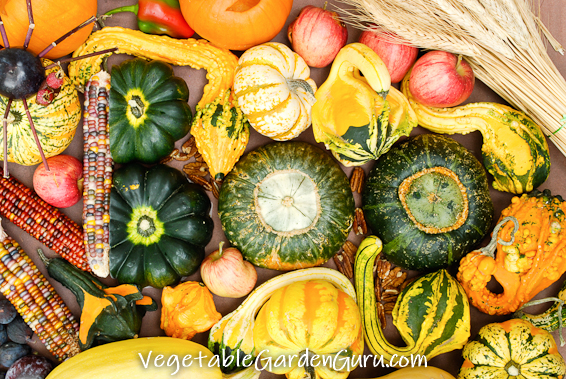- Home
- How to Grow Vegetables A-Z
- Growing Winter Squash
Growing Winter Squash
Beginning gardeners sometimes think that growing winter squash is a wintertime activity (which I suppose it is if you live where it’s 80 degrees all winter!). Winter squash is so named because it’s a great storage vegetable, and has been used for thousands of years as a calorie and vitamin source to tide people over through the long winter months, until spring vegetables become available again.
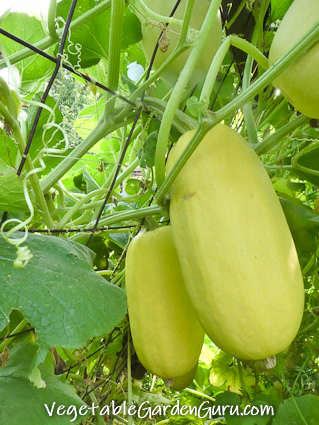
The early peoples of the American southwest relied on winter squash as one of their staple foods. They grew winter squash along with corn and beans in the same spot, a combination they reverently called “The Three Sisters”.
The brilliance of this combination is that the beans provide nitrogen for the corn, the corn provides the beans with a trellis to climb, and the winter squash provides a rain-retaining living mulch which shades the soil from the parching effect of the sun, which in the desert southwest is very intense! But the biggest benefit is that all three are wonderful storage crops.
Growing Winter Squash: Choices, Choices...
One of the hardest things about growing winter squash is choosing a variety! There are so many to choose from it can be a bit overwhelming. They fall into 4 main species, which branch out into hundreds of varieties that vary dramatically in shape, color, size, shelf life, sweetness, flavor and texture.
My personal faves are Delicata, the big-old-ugly-delicious Hubbard, and Sweetmeat "Oregon Spring" (reclaimed by Carole Deppe at Oregon State). A good way to find your own favorites (before spending a summer growing them) is to visit farmer's markets in the fall and try out some different ones. Browse the seed catalogs carefully, paying attention to the length of your growing season, and the flavor and texture descriptions in the catalogs. Johnny's has 64 pages of squash varieties online!
Just for fun here is a Halloween winter squash sculpture I made with acorn, buttercup, carnival and spaghetti winter squashes, small and mini pumpkins, ornamental gourds, "Indian" corn, apples, wheat, and a spider made out of a black plum, crabapples and twigs.
Growing Winter Squash Takes SPACE
A phenomenal study done by Dr. John Weaver, PhD at the University of Nebraska in 1927 documented the root spread of many different vegetable crops. His study revealed that winter squash roots may grow up to 40" deep and 20 feet across!
I used to recommend giving 3-4 feet of space per plant, but after seeing Weaver's drawings I realize they need as much space as you can spare, especially if you are looking to optimize their nutritional quality and flavor, At the absolute minimum give them a 5-foot diameter circle per plant, while realizing that their roots underground are going to extend out, unseen, all over your garden. Winter squashes are heavy feeders and appreciate a deeply worked, very fertile soil rich in organic matter.
Space is why people often plant squash in a tilled patch rather than a row. The patch is sometimes erroneously referred to as a “hill” (see side box).
Above ground, winter squash are notorious wanderers, and they will sprawl all over the garden if you don’t train them where you want. The space requirement depends on variety, so check your seed packet, and remember that their underground root area will be even greater than their above-ground spread.
A well-built trellis is a beautiful and practical thing, especially in late fall when the squash plants have died back to reveal a hanging harvest of winter squash! If you’re short on ground or are growing in raised beds, consider growing up! (Not that I’d know anything about that, at 67 I still wear purple Keen kid’s shoes).
You can also plant winter squash near a chain-link fence, which makes a wonderful, sturdy trellis for small to medium-sized squash. (Just don’t try to grow your 75-pound, state-fair pumpkins there…).
Growing Winter Squash Requires Very Fertile Soil
Growing winter squash requires very fertile soil, so prepare your soil as deeply as you can with a LOT of rich homemade compost. If leaves start to yellow later in the season, you can make your plants happy again by giving them a bit of higher-nitrogen organic fertilizer like fish emulsion or blood meal.
And since all squash is notoriously prone to powdery mildew, they will do better if watered from below with drip or leaky-pipe hose if you live where it is hot. They also benefit greatly by being sprayed once in awhile (when it’s cool!) with actively-aerated compost tea, which provides microorganisms that help defend again fungus. Another great option for spraying is raw milk (though under US law, it is illegal to buy/sell raw milk!)
When to Plant Winter Squash
Direct-seed winter squash... do not start them indoors for transplant. While it's hard to wait sometimes, winter squashes (like peppers) are extremely sensitive to root damage, and your yields will be much higher (and earlier!) if you're patient and just wait till the soil is good and warm.
Bugs and Other Strangers
As mentioned above, the most common problem in squashes of all kinds is powdery mildew. But squash family plants are also susceptible to squash bugs (left), squash vine borers (center) and striped cucumber beetles (right, but they come in many variations).
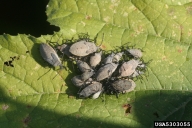
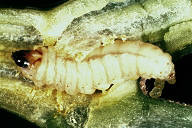
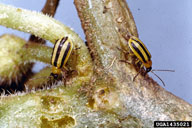
The best control is prevention, which means growing your squash under row cover. This is less practical if you’re growing winter squash up a trellis. Row cover also doesn’t make for the most, err…. photogenic backyard vegetable garden, either, but honestly, it’s the only thing that’s reasonably effective against all kinds of squash bugs. But once you see bugs, it's too late for row cover.
Once you notice the first squash bug, you’re in for a summer’s battle. They are hard to control organically (even chemical gardeners don’t have much success against them.) The best you can do is find ‘em, squash em, and squash their eggs. Don’t compost the spent plants at the end of the year, and use row cover if you can the following year. Not very optimistic, I know.
I wondered if
backyard chickens or ducks would help - but now that I have ducks I can say "no". Though I'm sure they would love squash beetles, one of their very favorite foods is winter squash leaves.
Harvesting Winter Squash
How to Tell When Winter Squash Are Ripe
Most winter squash varieties take 50-55 days from pollination of the flower (aka "fruit set") to maturity. But since you're probably not out there marking flowers the day of pollination, a better way to tell is to do a scratch test. For the larger variety of squash, like butternut and Hubbard, the skins will be quite hard and resistant to scratching with a fingernail. With other types, they're usually ripe when they start to get kind of waxy on the outside.
Leave a couple of inches of stem on the squashes when you cut them off. If you just pull them off the vine with no stem, they will dry out too much. Do not wash them, as the good bacteria on the surface help keep mold in check.
Just because vines die at
the end of the season - because the powdery mildew finally caught up
with
them, or the drought, or eventually (sigh) the first frost - don’t
assume everything left hanging on the vines is ripe. Eat any
unripe ones first (or compost them if you don't like the taste), as they
won't keep. Be sure to check out my winter squash recipes page.
READ MORE:
Happy Thanksgiving
Turkey is great, but somehow Thanksgiving to me means all the colorful squashes and other gifts that Mother Earth has poured into my life from a little seed and a bit of ground. So...

You Are Here: Vegetable Gardening Home > Growing Vegetables A-Z > Growing Winter Squash
Help share the skills and spread the joy
of organic, nutrient-dense vegetable gardening, and please...
~ Like us on Facebook ~
Thank you... and have fun in your garden!
Affiliate Disclaimer
This website contains affiliate links to a few quality products I can genuinely recommend. I am here to serve you, not to sell you, and I do not write reviews for income or recommend anything I would not use myself. If you make a purchase using an affiliate link here, I may earn a commission but this will not affect your price. My participation in these programs allows me to earn money that helps support this site. If you have comments, questions or concerns about the affiliate or advertising programs, please Contact Me.Contact Us Page
